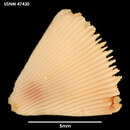en
names in breadcrumbs


"Sphenotrochus gardineri Squires, 1961
Sphenotrochus intermedius; Gardiner, 1939, p. 333 (part: Discovery sta. 388).
Sphenotrochus gardineri Squires, 1961, pp. 26-28, 29, text figs. 6-8; 1969, p. 17, pi. 6, map 1.—Cairns, 1979, p. 206.
Description. Corallum attached in younger stage. Base usually evenly rounded, but lateral edges of some specimens may form an apical angle of 50°-60°. Corallum cuneiform, highly compressed, with range of GCD/LCD of 1.5-2.2. Largest specimen known (Vema. sta. 15-109) 9.3 x 4.4 mm in CD and 10.1 mm tall. Prominent, vertical costae correspond to all septa, with infrequent branching. The two principal (directive) costae, occurring on lateral edges, continuous to base, as are some costae on lateral faces; however, most costae originating at intercostal grooves flanking principal costae (Plate 8, fig. 3). Costae separated by deep, wide intercostal grooves. Row of low, rounded granules on each costa, sometimes becoming two granules wide near calice.
Septa hexamerally arranged in four cycles. S1, S2, and S3 equal in size and exsertness, except for the 2 principal septa, these aligned with columella and considerably larger than other four S1. S4 considerably smaller; S5 sometimes present in half systems adjacent to principals. Coralla with less than 48 septa, 10 or 11 half systems, common. S1-3 having coarsely dentate upper and inner edges, these merging with columella. Inner edges of S4 finely dentate. Septal granules large and blunt, arranged in distinct lines originating from an axis of divergence well inside theca. Fossa shallow. Columella composed of five to eight linearly arranged rods, these fused basally; never lamellar.
Remarks. Although adult coralla are always free, young specimens are initially attached to a substrate, such as sand particles of 0.1-0.2 mm in diameter. At a GCD of 2.5 mm, coralla have usually attained a full third cycle of septa, but costae and columella have not yet developed. A glossy epitheca is usually present. At a greater size, costae begin to develop and eventually overgrow the epitheca and original attachment, including the sand particle, at which point the coral becomes free. Coralla may also bud asexually from fragments of a parent specimen.
Discussion. S. gardineri is distinguished from other Recent Sphenotrochus, all of which are fairly localized in distribution. The following species are distinguished on the basis of their lamellar columella: S. hancocki Durham and Barnard, 1952 (Galapagos Islands; off California); S. auritus Pourtales, 1874 (tropical western Atlantic); S. gilchristi Gardiner, 1904; S. aurantiacus Marenzeller, 1904 (both off South Africa); and S. excavatus T. Woods, 1878 (off Australia). Most of these species also have only three cycles of septa. S. andrewianus Milne Edwards and Haime, 1848. (northeast Atlantic), has a lamellar or papillose columella but only three cycles of septa. Finally, S. ralphae Squires, 1964 (off New Zealand) [Squires, 1964b], has a similar columella, but its corallum is smaller and narrower and has fewer septa.
Material. Eltanin sta. 980 (2), USNM 47430. Hero sta. 712-656 (5), USNM 47432; sta. 715-694 (1), USNM 47434; sta. 715-902 (5), USNM 47433; sta. 715-903 (5), USNM 47428. Vema sta. 14-14 (4), USNM 47435; sta. 14-16 (1), USNM 47431; sta. 15-109 (2), USNM 47429; sta. 17-11 (2), USNM 47427. Specimens of Gardiner [1939] from Discovery sta. 388 (2), MCZ; specimens of Squires [1961] from Vema sta. 14-14 (5), AMNH. Holotype.
Tvpes. The holotype is deposited at the American Museum of Natural History (3367). It was collected at Vema station 14-14. Type-locality: 54°23'S 62°25’W (Burdwood Bank); 75 m.
Distribution. Endemic to Magellanic region from Tierra del Fuego to Chiloe, Chile (Map 5). Depth range: 9-403 m." Cairns 1982, pp. 26-27, Plate 8, figs. 2-8